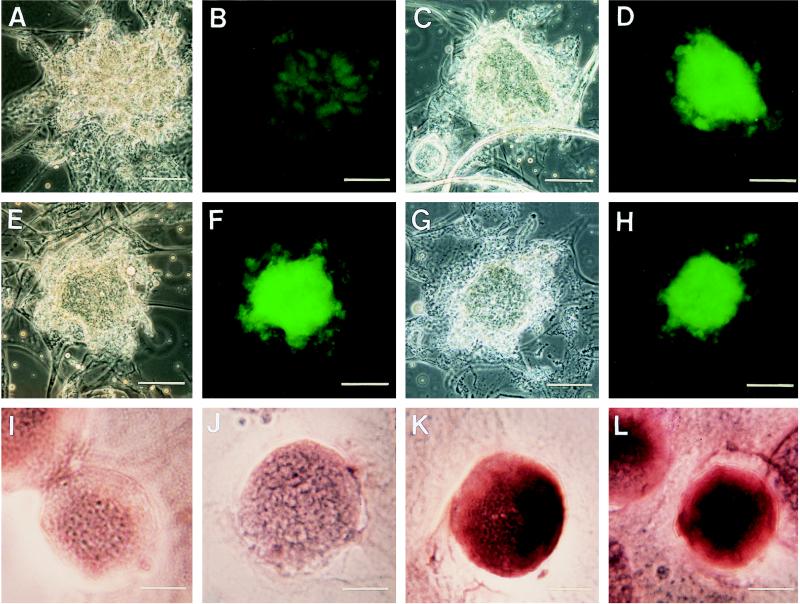Figure 1.
In situ hybridization of Histochoice-preserved specimens using oligodeoxynucleotide probes complementary to the 16S-like (small subunit) rRNA sequences of acantharia (A–H) and colonial spumellaria (I–L). For both acantharian and colonial spumellarian cells, probes conjugated to biotin were detected by either FITC–avidin or streptavidin–alkaline phosphatase-conjugated secondary labels. For the acantharian cells, hybridization was detected by epifluorescence microscopy with settings specific for FITC excitation (B, D, F, and H). Colonial spumellarian cells were viewed using phase contrast microscopy, and hybridizations were detected colorimetrically using the localized, purple precipitate of the enzymatic reaction of alkaline phosphatase on nitroblue tetrazolium and 5-bromo-4-chloro-3-indolylphosphate substrates. (A–H) Four different acantharian cells of the same species with corresponding transmitted light and epifluorescence photomicrographs of the same cell. Epifluorescence photomicrographs were taken with an integral camera system using a FITC filter set consisting of a 450- to 490-nm band-pass excitation filter, a 510-nm long-pass dichroic mirror, and a 515- to 565-nm band-pass emission filter. Fuji 100 ASA Provia color slide film was used for fluorescence pictures. Transmitted light photomicrographs of samples were taken with an Olympus OM4-T camera using Kodak 160 speed Tungsten film. All exposure times for a set of samples (i.e., negative control, positive control, taxon-specific probes) were kept constant so that the relative intensity was indicative of probe binding. (Bars = 75 μm for A–H.) (A and B) The negative control to which only FITC–avidin was added. Note the minimal background fluorescence of the cell under epifluorescence (B). (C and D) The positive control treatment to which a eukaryotic-specific probe designed to target all eukaryotes (EUK 1209R) was added. (E–H) Probing with two different acantharian probes (F, A497; H, A899). (I–L) Hybridization results for single individuals within the same spumellarian colony. (I) The negative control to which only the streptavidin-alkaline phosphatase-conjugated secondary label was added. (J) A negative probe control to which an acantharian probe was added. (K) The results of the positive control hybridization with eukaryote probes (EUK502R and EUK1209R). (L) Hybridization with colonial spumellarian probes (R906 and R1451). (Bars = 35 μm for I–L.)

